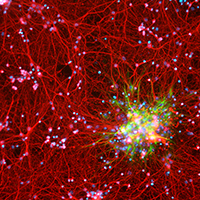Quantitative, structural and molecular changes in neuroglia of aging mammals: A review

Accepted: 27 May 2021
HTML: 11
All claims expressed in this article are solely those of the authors and do not necessarily represent those of their affiliated organizations, or those of the publisher, the editors and the reviewers. Any product that may be evaluated in this article or claim that may be made by its manufacturer is not guaranteed or endorsed by the publisher.
Authors
The neuroglia of the central and peripheral nervous systems undergo numerous changes during normal aging. Astrocytes become hypertrophic and accumulate intermediate filaments. Oligodendrocytes and Schwann cells undergo alterations that are often accompanied by degenerative changes to the myelin sheath. In microglia, proliferation in response to injury, motility of cell processes, ability to migrate to sites of neural injury, and phagocytic and autophagic capabilities are reduced. In sensory ganglia, the number and extent of gaps between perineuronal satellite cells – that leave the surfaces of sensory ganglion neurons directly exposed to basal lamina– increase significantly. The molecular profiles of neuroglia also change in old age, which, in view of the interactions between neurons and neuroglia, have negative consequences for important physiological processes in the nervous system. Since neuroglia actively participate in numerous nervous system processes, it is likely that not only neurons but also neuroglia will prove to be useful targets for interventions to prevent, reverse or slow the behavioral changes and cognitive decline that often accompany senescence.
How to Cite
PAGEPress has chosen to apply the Creative Commons Attribution NonCommercial 4.0 International License (CC BY-NC 4.0) to all manuscripts to be published.
Similar Articles
- CarloAlberto Redi, Mouse cell culture - Methods and protocols , European Journal of Histochemistry: Vol. 54 No. 4 (2010)
- M. Kawashima, K. Imura, I. Sato, Topographical organization of TRPV1-immunoreactive epithelium and CGRP-immunoreactive nerve terminals in rodent tongue , European Journal of Histochemistry: Vol. 56 No. 2 (2012)
- R. Vaccaro, E. Parisi Salvi, I. Nofroni, I. D’Este, S.M. Baglaj, T. Renda, Endocrine cells in atresic chick embryo intestine: histochemical and immunohistochemical study , European Journal of Histochemistry: Vol. 53 No. 3 (2009)
- S Desantis, M Labate, A Corriero, GM Labate, G De Metrio, Immunohistochemical evidence of seasonal changes of gonadotropes in male ruin lizard (Podarcis sicula campestris De Betta) , European Journal of Histochemistry: Vol. 44 No. 4 (2000)
- W. Meyer, M. Liumsiricharoen, A. Suprasert, L.G. Fleischer, M. Hewicker-Trautwein, Immunohistochemical demonstration of keratins in the epidermal layers of the Malayan pangolin (Manis javanica), with remarks on the evolution of the integumental scale armour , European Journal of Histochemistry: Vol. 57 No. 3 (2013)
- SA Abd-El-Aleem, C Morgan, MVJ Ferguson, CN McCollum, GW Ireland, Spatial distribution of mast cells in chronic venous leg ulcers , European Journal of Histochemistry: Vol. 49 No. 3 (2005)
- M. Artico, E. Bronzetti, V. Alicino, B. Ionta, S. Bosco, C. Grande, M. Bruno, F. M. Tranquilli Leali, G. Ionta, L. Fumagalli, Human gallbladder carcinoma: Role of neurotrophins, MIB-1, CD34 and CA15-3 , European Journal of Histochemistry: Vol. 54 No. 1 (2010)
- A. Porzionato, V. Macchi, A. Amagliani, I. Castagliuolo, A. Parenti, R. De Caro, Neurotensin receptor 1 immunoreactivity in the peripheral ganglia and carotid body , European Journal of Histochemistry: Vol. 53 No. 3 (2009)
- S. Marzo, V. Galimberti, M. Biggiogera, Unexpected distribution of KRIT1 inside the nucleus: new insight in a complex molecular pathway , European Journal of Histochemistry: Vol. 58 No. 1 (2014)
- N.P.E. Kadoglou, P. Moustardas, A. Kapelouzou, M. Katsimpoulas, A. Giagini, E. Dede, N. Kostomitsopoulos, P.E. Karayannacos, A. Kostakis, C.D. Liapis, The anti-inflammatory effects of exercise training promote atherosclerotic plaque stabilization in apolipoprotein E knockout mice with diabetic atherosclerosis , European Journal of Histochemistry: Vol. 57 No. 1 (2013)
<< < 38 39 40 41 42 43 44 45 46 47 > >>
You may also start an advanced similarity search for this article.

 https://doi.org/10.4081/ejh.2021.3249
https://doi.org/10.4081/ejh.2021.3249










